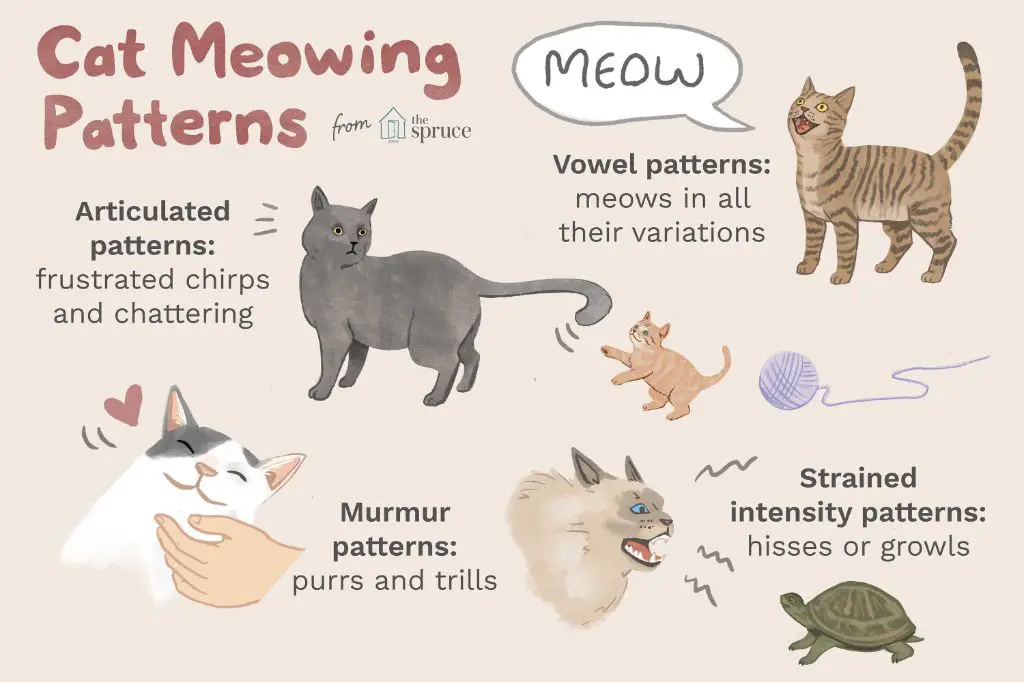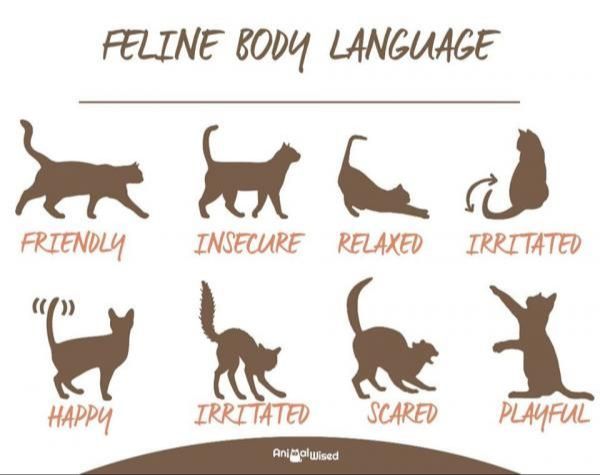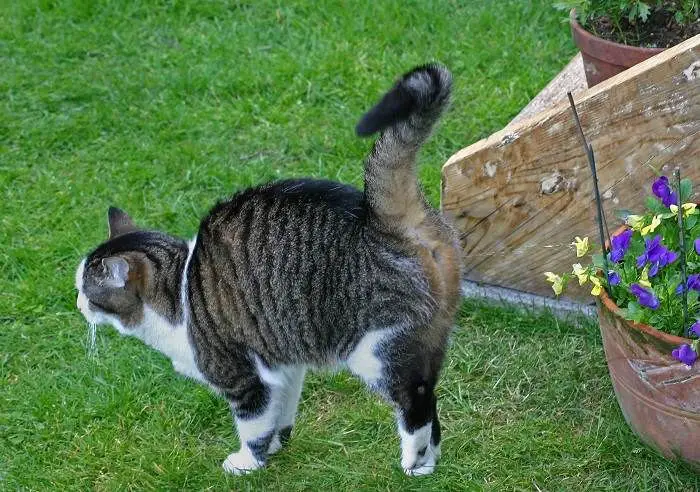Cats have complex communication abilities that allow them to express themselves and understand each other. While often perceived as aloof and independent, cats in fact have sophisticated methods of interacting. Vocalizations, body language, and scent marking are some of the key ways cats communicate.
Cats make over 100 different vocal sounds to express various emotions and needs. From the familiar meow and purr, to chirps and growls, cat vocalizations convey a range of messages. Body language, including facial expressions, ear and tail positioning, and posture, also play an important role. For example, an erect tail signals confidence, while a swishing tail can indicate agitation.
Cats also rely heavily on scent signals. By secreting pheromones and depositing scents by rubbing, scratching, and urine marking, they effectively spread information. Scent exchange is a vitally important means of communication between cats.
Understanding how cats communicate provides insight into their behavior and needs. Recognizing their various vocalizations, body language, and scent signals allows for improved bonds and caretaking.
Meowing
Cats use various vocalizations like meows, mews, and murmurs to communicate with each other (https://www.rover.com/blog/how-do-cats-communicate-with-each-other/). Meows, mews, and murmurs constitute a significant part of cat communication. Variations in pitch and tone of these vocalizations convey different meanings. For example, an urgent cry can signal distress while a low purr often indicates contentment. Kittens meow frequently to their mothers when hungry or cold as a way to get attention and care. As cats grow into adults, they use meows primarily to communicate with humans rather than other cats. Adult cats realize humans respond to meows so they continue meowing to get our attention. Cats rarely meow to each other as adults unless it is mothers communicating with kittens (https://www.loc.gov/item/how-do-cats-communicate-with-each-other/).

Purring
Cats often purr when they are content, such as when being petted or sitting on a human’s lap. The rhythmic vibrations of purring indicate contentment and can have a soothing effect on both the cat and the human (https://www.webmd.com/pets/cats/why-do-cats-purr). However, cats may also purr in situations of injury, illness, or stress. The reason for this is not entirely understood, but some experts suggest the vibrations from purring may help promote healing or have a self-soothing effect for the cat.
There are a few hypotheses for why cats purr in stressful situations. One is that the vibrations help stimulate bone growth and healing. Purring creates vibrations at a frequency between 25-50 Hz, which can help strengthen bones and reduce muscle atrophy (https://www.newscientist.com/question/why-do-cats-purr/). Purring may also release endorphins that serve as a natural painkiller for the cat. Additionally, the act of purring during times of distress may be self-soothing or comforting for the cat.
Body Language
Cats use their bodies to communicate their moods and emotions. Tail, ear, and whisker movements along with facial expressions and postures all give insight into how a cat is feeling.

A cat’s tail can reveal a lot. An upright, quivering tail indicates excitement and interest. A relaxed, gently swishing tail shows contentment. An aggressively thumping tail often means annoyance. And a tucked tail signals fear or uncertainty (source).
Ear positions also convey meaning. Ears pointed up and forward indicate alertness. Flattened ears back against the head often mean fear or aggression. And ears swiveled to the sides shows a relaxed mood (source).
Whiskers pointing forward signals interest and focus. Whiskers pushed back against the face can mean uncertainty or distrust of a situation.
Facial expressions like widened eyes or exposed teeth indicate fear or defensiveness. Slow blinking shows comfort and trust. Yawning, licking lips, or grooming may signal stress.
Arching the back, hissing, or swatting are aggressive behaviors. Crouching with ears back displays fear. Rolling over to expose the belly indicates trust and comfort with an individual or environment.
Scent Marking
Cats have a remarkably strong sense of smell due to their specialized olfactory system. They have around 200 million odor-sensitive receptors in their noses, compared to only 5 million in humans.[1] This powerful sense of smell allows cats to leave behind scent markings that communicate important information to other cats.

One way cats mark their territory is by rubbing and scratching objects. When a cat rubs its face on an object, it deposits pheromones from glands around its mouth and cheeks. These pheromones signal a cat’s ownership of an area and mark it as their domain. Cats also scratch objects like furniture or tree trunks to leave both a visual mark and a scent mark from the pheromones on their paw pads.
Another key scent marking behavior is urine spraying. Although both male and female cats spray, unneutered males do so more frequently. When a cat sprays urine on vertical surfaces like walls, it sends a message about its sexual status and conveys a sense of territory ownership to other cats in the area.[2]
These scent marking behaviors allow cats to effectively communicate and establish boundaries without direct confrontation. Their keen sense of smell allows cats to gather a wealth of information from the pheromones and scents left behind by other felines.
Tactile Communication
Cats use touch to communicate in various ways. One common form of tactile communication is called allogrooming. This is when two cats rub against each other and groom one another. Allogrooming helps strengthen social bonds between cats (Cat Communication – International Cat Care).
Another important form of tactile communication is play fighting. Kittens will play fight with their littermates and mothers to develop important hunting and fighting skills. Play fighting allows them to practice things like stalking, pouncing, wrestling, and biting within a safe context (How Cats Communicate – FOUR PAWS International).
Cats have many sensitive nerve endings in their skin and fur that allow them to pick up subtle tactile cues from other cats. Touch is a nuanced way cats get social information to bond with others, establish dominance, and learn vital skills.
Visual Signs
Cats communicate a lot through their eyes and other visual signals. Making direct eye contact is one way cats show dominance and aggression toward other cats or humans. Staring with unblinking eyes can be a threatening gesture. On the other hand, slow blinking shows affection and trust. When a cat slowly blinks at you, it’s a way for them to say “I love you.” Dilated pupils are another visual cue that indicates a cat feels aggressive or threatened. Wide dilated pupils allow the cat to see better and prepare to respond to danger.
According to the experts at The Spruce Pets, “Cat eyes that stare unblinkingly from a distance can be a sign of control, dominance, or even aggression. Owners often won’t recognize this behavior for what it is.” (1) Rover concurs that “Wide eyes with dilated pupils are a hallmark sign an alert and engaged cat.” (2)
(1) https://www.thesprucepets.com/cat-talk-eyes-553942
(2) https://www.rover.com/blog/cat-eyes-meaning/
Vocalizations
Cats make a variety of vocal sounds to communicate with each other. Some of the main vocalizations include growling, yowling, chirping and chattering.

Growling is a low, guttural sound that signals a warning. It often occurs when a cat feels threatened or annoyed. According to Modern Cat, growling “tells other cats to back off before a fight ensues.”1
Yowling is an intense, loud, long meow. It can signal distress, get a human’s attention, or communicate with other cats over longer distances. Female cats may yowl when in heat to attract potential mates.2
Chirping is a high-pitched mew that cats make when observing prey or other animals out of a window. It signals excitement, interest or intent to hunt. Chattering is a similar staccato vibration cats make by rapidly moving their jaws while looking at prey they cannot reach.
Understanding the context around different feline vocalizations provides insight into a cat’s inner state and intentions. Paying close attention to growls, yowls, chirps and chatters can help strengthen the bond between cats and their human companions.
Solitary Hunters
Cats are often thought of as solitary creatures that prefer to be alone. This is partially true as cats are not as intensely social and cooperative as dogs. However, cats still have complex social lives and ways of communicating with each other.
In the wild, feral cats generally live, hunt, and raise their young alone. But they still maintain social groups and have areas of home ranges that overlap, allowing them to interact when they choose. Females will raise a litter together, and young cats often form groups after separating from their mother (Source).
Domestic cats are similar in that they can thrive in solitary environments like apartments. But given the choice, most pet cats opt to live with other cats and use complex means of cat-to-cat communication. They just socialize on their own terms, not necessarily when and how humans expect them to.
Conclusion
Cats have a rich and complex system of communication that includes vocalizations, body language, scent marking, and tactile interactions. By understanding the main ways cats communicate, cat owners can better interpret their pet’s needs and emotions.
Some of the key cat communication methods include meowing, purring, rubbing, kneading, scratching, tail movements, ear positions, eye dilation, and facial expressions. Meowing is a recognizable cat vocalization, while purring demonstrates contentment. Cats have scent glands on areas like their cheeks and tails that they use to rub and mark territory. Kneading with front paws and scratching are tactile signals.
To strengthen their bond with their cat, owners should learn to read their subtle body language cues. Paying close attention to ear and tail movements, eye dilation, and vocal tones can help owners better understand their cat’s current state and needs. Providing adequate outlets for natural cat behaviors like scratching and enriching their environment is also important. Overall, cat owners who make the effort to understand feline communication will be rewarded with a closer relationship with their pet.

